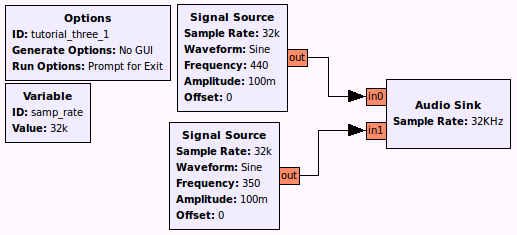Flowgraph Python Code
Dial Tone Flowgraph
The following is a dial-tone example using gnuradio-companion (GRC).

When we click the Generate button, the terminal tells us it produced a .py file, so let's open that to examine its code.
#!/usr/bin/env python3
# -*- coding: utf-8 -*-
#
# SPDX-License-Identifier: GPL-3.0
#
# GNU Radio Python Flow Graph
# Title: tutorial_three_1
# GNU Radio version: 3.8.0.0
from distutils.version import StrictVersion
if __name__ == '__main__':
import ctypes
import sys
if sys.platform.startswith('linux'):
try:
x11 = ctypes.cdll.LoadLibrary('libX11.so')
x11.XInitThreads()
except:
print("Warning: failed to XInitThreads()")
from gnuradio import analog
from gnuradio import audio
from gnuradio import gr
from gnuradio.filter import firdes
import sys
import signal
from PyQt5 import Qt
from argparse import ArgumentParser
from gnuradio.eng_arg import eng_float, intx
from gnuradio import eng_notation
from gnuradio import qtgui
class tutorial_three_1(gr.top_block, Qt.QWidget):
def __init__(self):
gr.top_block.__init__(self, "tutorial_three_1")
Qt.QWidget.__init__(self)
self.setWindowTitle("tutorial_three_1")
qtgui.util.check_set_qss()
try:
self.setWindowIcon(Qt.QIcon.fromTheme('gnuradio-grc'))
except:
pass
self.top_scroll_layout = Qt.QVBoxLayout()
self.setLayout(self.top_scroll_layout)
self.top_scroll = Qt.QScrollArea()
self.top_scroll.setFrameStyle(Qt.QFrame.NoFrame)
self.top_scroll_layout.addWidget(self.top_scroll)
self.top_scroll.setWidgetResizable(True)
self.top_widget = Qt.QWidget()
self.top_scroll.setWidget(self.top_widget)
self.top_layout = Qt.QVBoxLayout(self.top_widget)
self.top_grid_layout = Qt.QGridLayout()
self.top_layout.addLayout(self.top_grid_layout)
self.settings = Qt.QSettings("GNU Radio", "tutorial_three_1")
try:
if StrictVersion(Qt.qVersion()) < StrictVersion("5.0.0"):
self.restoreGeometry(self.settings.value("geometry").toByteArray())
else:
self.restoreGeometry(self.settings.value("geometry"))
except:
pass
##################################################
# Variables
##################################################
self.samp_rate = samp_rate = 32000
##################################################
# Blocks
##################################################
self.audio_sink_0 = audio.sink(samp_rate, '', True)
self.analog_sig_source_x_1 = analog.sig_source_f(samp_rate, analog.GR_COS_WAVE, 350, 0.1, 0, 0)
self.analog_sig_source_x_0 = analog.sig_source_f(samp_rate, analog.GR_COS_WAVE, 440, 0.1, 0, 0)
##################################################
# Connections
##################################################
self.connect((self.analog_sig_source_x_0, 0), (self.audio_sink_0, 0))
self.connect((self.analog_sig_source_x_1, 0), (self.audio_sink_0, 1))
def closeEvent(self, event):
self.settings = Qt.QSettings("GNU Radio", "tutorial_three_1")
self.settings.setValue("geometry", self.saveGeometry())
event.accept()
def get_samp_rate(self):
return self.samp_rate
def set_samp_rate(self, samp_rate):
self.samp_rate = samp_rate
self.analog_sig_source_x_0.set_sampling_freq(self.samp_rate)
self.analog_sig_source_x_1.set_sampling_freq(self.samp_rate)
def main(top_block_cls=tutorial_three_1, options=None):
if StrictVersion("4.5.0") <= StrictVersion(Qt.qVersion()) < StrictVersion("5.0.0"):
style = gr.prefs().get_string('qtgui', 'style', 'raster')
Qt.QApplication.setGraphicsSystem(style)
qapp = Qt.QApplication(sys.argv)
tb = top_block_cls()
tb.start()
tb.show()
def sig_handler(sig=None, frame=None):
Qt.QApplication.quit()
signal.signal(signal.SIGINT, sig_handler)
signal.signal(signal.SIGTERM, sig_handler)
timer = Qt.QTimer()
timer.start(500)
timer.timeout.connect(lambda: None)
def quitting():
tb.stop()
tb.wait()
qapp.aboutToQuit.connect(quitting)
qapp.exec_()
if __name__ == '__main__':
main()
Once GRC has created a Python file, the user is free to modify it in any desired manner, such as changing parameters, sample rate, and even connections among the blocks.
Warning: After the Python file is modified, running GRC again with that flowgraph will wipe out your changes!
Dial Tone Python Code Dissected
Let's examine pertinent lines of the code:
#!/usr/bin/env python3
This tells the shell to use the Python3 interpreter to run this file.
from gnuradio import gr
from gnuradio import audio
from gnuradio import analog
This tells Python what modules to include. We must always have gr to run GNU Radio applications. The audio sink is included in the audio module and the signal source is included in the analog module.
class my_top_block(gr.top_block):
Define a class called "my_top_block" which is derived from another class, gr.top_block. This class is basically a container for the flow graph. By deriving from gr.top_block, we get all the hooks and functions we need to add blocks and interconnect them.
def __init__(self):
Only one member function is defined for this class: the function "init()", which is the constructor of this class.
gr.top_block.__init__(self)
The parent constructor is called.
sample_rate = 32000
ampl = 0.1
Variable declarations for sample rate and amplitude.
self.connect(src0, (dst, 0))
self.connect(src1, (dst, 1))
There are 2 inputs to the Audio Sink block. The first line connects the only output of src0 (350 Hz waveform) to the first input of dst (Audio Sink). The second line connects the only output of src1 (440 Hz waveform) to the second input of dst (Audio Sink).
Connecting the Blocks
self.connect(src0, (dst, 0))
self.connect(src1, (dst, 1))
The general syntax for connecting blocks is self.connect(block1, block2, block3, ...) which would connect the output of block1 with the input of block2, the output of block2 with the input of block3 and so on. We can connect as many blocks as we wish with one connect() call. However this only work when there is a one-to-one correspondence. If we go back to our initial flowgraph, there are 2 inputs to the Audio Sink block. The way to connect them is by using the syntax above. The first line connects the only output of src0 (350 Hz waveform) to the first input of dst (Audio Sink). The second line connects the only output of src1 (440 Hz waveform) to the second input of dst (Audio Sink). The code so far is equivalent to the flowgraph we have created in the beginning; the rest of the lines simply start the flowgraph and provide a keyboard interrupt.
if __name__ == '__main__':
try:
my_top_block().run()
except KeyboardInterrupt:
pass
Luckily we are past the early years of GNU Radio when there was no GRC to make the Python files for us. Nowadays we can simply click things together in GRC instead of having to write code in Python to build flowgraphs. Still, a good understanding of what is going on every time we run GRC is good to know as it gives us more control of what we want the program to do.